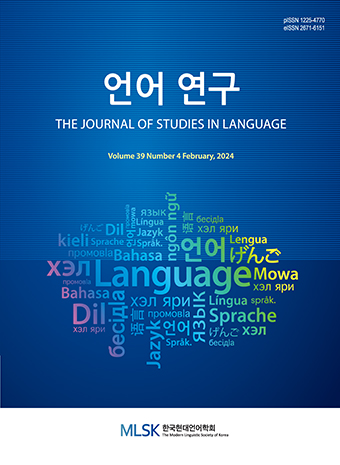Research Article
Abstract
References
Information
The current study has reviewed Korean double accusative constructions (DACs), which refer to constructions where two NPs marked with -(l)ul appear at the same time in a sentence. It gives rise to questions about which one is a grammatical object and what the other NP is in a sentence. To solve these questions, we have classified DACs into four types according to syntactic and semantic/pragmatic perspectives. There are four types of DACs: NP2 as a grammatical object, NP1 as a focus or topic; NP2 as a grammatical object, NP1 as a topic; NP1 as a grammatical object, NP2 as a modifier; NP1 as a grammatical object, NP2 as a part of the predicate. That is, in the first two types, NP2 is a grammatical object, while in the other two types, NP1 is a grammatical object. Additionally, the NP, which is not a grammatical object in the first three types, can be left out from a sentence, whereas it is obligatory in the last type.
- 국립국어연구원. 2019. 표준국어대사전. https://stdict.korean.go.kr.
- 신서인. 2016. 대격 중출구문에서의 ‘을/를’의 기능 연구: 타동성을 중심으로. 『우리말글』 68, 1-35.
- 이희자·이종희. 1998. 『사전식 텍스트 분석적 국어 어미의 연구.』 서울: 한국문화사.
- Ahn, H.-D. 1990. On Light Verb Constructions in Korean and Japanese. Japanese Korean Linguistics 1, 221-237.
- Choi, Y. S. 2016. Verbal Noun in Korean Light Verb Construction Redux. The Journal of Studies in Language 32.1, 115-140. 10.18627/jslg.32.1.201605.115
- Chung, E. 2015. A Construction Grammar Approach to Korean Double Accusative Construction. Language Information 21, 41-66.
- Goldberg, A. E. 1995. Constructions: A construction Grammar Approach to Argument Structure. Chicago: University of Chicago Press.
- Grimshaw, J. and A. Mester. 1988. Light Verbs and ɵ-marking. Linguistic Inquiry 19, 205-232.
- Han, C.-H., J. Lidz, and J. Musolino. 2007. Verb-raising and Grammar Competition in Korean: Evidence from Negation and Quantifier Scope. Linguistic Inquiry 38.1, 1-47. 10.1162/ling.2007.38.1.1
- Hopper, P. J. and S. A. Thompson. 1980. Transitivity in Grammar and Discourse. Language 56.2, 251-299. 10.1353/lan.1980.0017
- Kim, J.-B. 2016. The Syntactic Structures of Korean. New York: Cambridge University Press. 10.1017/CBO9781316217405
- Kwon, J. 2012. Middle Field Scrambling as Topicalization. The Association of Modern British and American Language and Literature 30.3, 151-171.
- Lee, H. and J. Lee. 1998. A Study of Korean Particle Based on the Analysis of Dictionary Text. Han’guk Munhwasa.
- Lee, K. 2012. Focus and Floating Numeral Quantifiers in Korean. Master’s Thesis, Kyungpook National University.
- Lee, K. and W. Park. 2019. Categorization of Double Nominative Constructions in Korean: Based on the Properties of –i/-ka. English 21 32.1, 249-266. 10.35771/engdoi.2019.32.1.012
- Lee, M.-J. 2001. The Light Verb hata Construction and English Loans. Harvard Studies in Korean Linguistics 9, 552-562.
- Park, S.-Y. 2014. Two Types of Adnominal Particle ‘uy’ in Korean: Genitive and Modificational ‘uy’. Studies on Modern Grammar 81, 1-27. 10.14342/smog.2014.81.1
- Son, G. 2012. Overt Focus Movement to the Edge of vP. Ms., Kyungpook National University.
- Yi, H.-S. 2004. On the Meaning of the Particle ‘eul’. Korean Semantics 15, 303-327.
- Yoon, James H. S. 2015. Double Nominative and Accusative Constructions. The Handbook of Korean Linguistics 79-97. 10.1002/9781118371008.ch5 26217387 PMC4513173
- Publisher :The Modern Linguistic Society of Korea
- Publisher(Ko) :한국현대언어학회
- Journal Title :The Journal of Studies in Language
- Journal Title(Ko) :언어연구
- Volume : 35
- No :3
- Pages :389-399
- DOI :https://doi.org/10.18627/jslg.35.3.201911.389



 The Journal of Studies in Language
The Journal of Studies in Language





